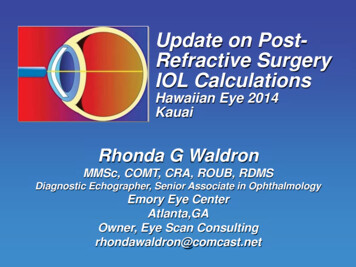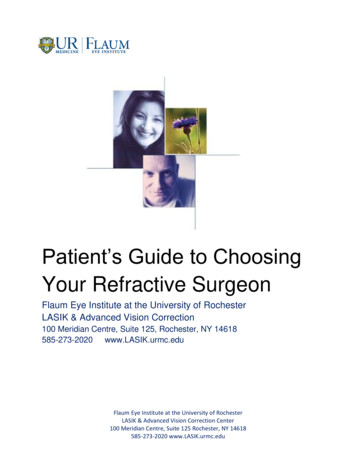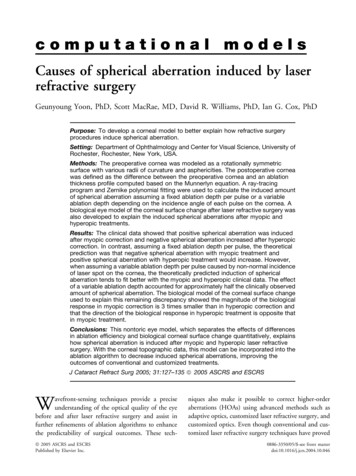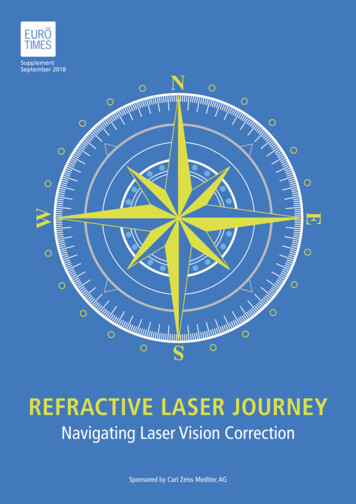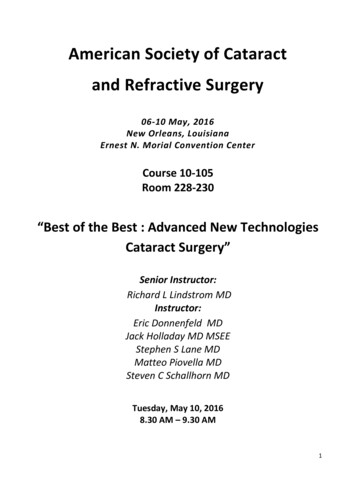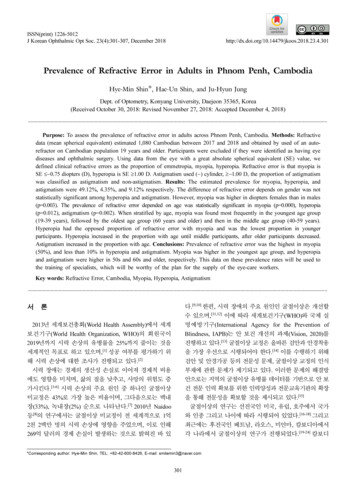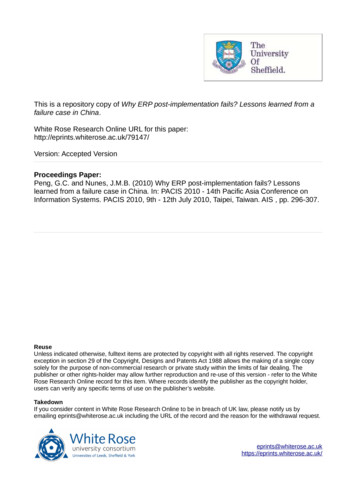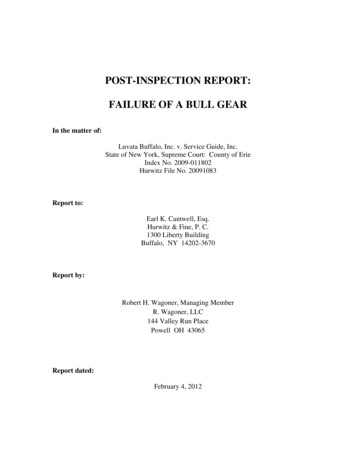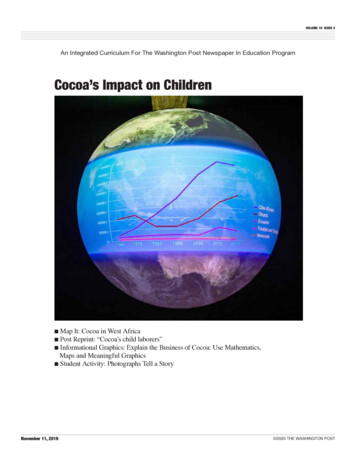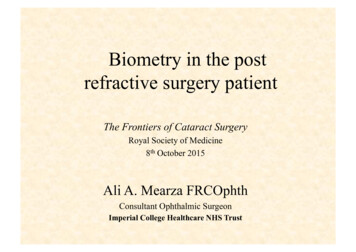
Transcription
Biometry in the postrefractive surgery patientThe Frontiers of Cataract SurgeryRoyal Society of Medicine8th October 2015Ali A. Mearza FRCOphthConsultant Ophthalmic SurgeonImperial College Healthcare NHS Trust
Background A significant number of patients coming forcataract / RLE surgery will have had previouslaser refractive surgery With increasing use of “premium lenses”,accuracy of IOL calculation is critical Patient expectations are forever on the increase
Outline Why miscalculations occur Methods to improve accuracy of IOL calculations Clinical Approach Options when faced with a refractive surprise
Variables in IOL Power Formulas Corneal Power ( Average K) Axial Length Effective Lens Position (Calculation of AC Depth) White to White Diameter (WTW) Lens thickness
Corneal Power is main problem Most manual keratometers / topography systems use acorneal index of refraction of 1.3375 Assumption that the posterior radius of curvature is1.2 mm less than the anterior ROC Assumption that the anterior and posterior ROC’s areparallel Corneal power is used in the prediction of effective lensposition (ELP), which is the depth of the IOL relative to thecornea
Why is the corneal powerinaccurate?Calculation of Total Corneal Power:Power (D) (nc - na ) / rnc index of refraction of the cornea (Typically 1.3375)na index of refraction of air (normally 1)r anterior radius of curvature of the cornea
Why is the corneal powerinaccurate?Calculation of Total Corneal Power:Power (D) (nc - na ) / rnc index of refraction of the cornea (Typically 1.3375)na index of refraction of air (normally 1)r anterior radius of curvature of the cornea
After LASIK / PRK Change in anterior radius of curvature No change in posterior ROC Therefore, there is inaccurate calculation of thecorneal power from a correctly measured anteriorradius of curvature Myopic treatments reduce the power of thecornea- results in under-estimation of lens power Hyperopic treatments results in over-estimation oflens power
Measured Corneal Power Over-estimation of the true corneal powerSeitz B et al. Underestimation of intraocular lens power for cataractsurgery after myopic PRK. Ophthalmology 1999; 106:693-702 Manual Keratometry over-estimates by 36% Topography over-estimates by up to 56% Corneal power over-estimation worse the higher thelaser correction e.g. correction of –5.00 leads to a 1Dioptre over-correction of corneal power
Methods to calculate true cornealpower Different formulas used based on the dataavailable i.e. if we have pre-op K’s and refractionor not
Clinical History Method(Holladay, Hoffer)Pre KR Mean K 44.00 DChange in SEQ Ref -4.50 DCalc Mean K 39.50 D
Subtraction of 24% SEQ Change(Holladay)e.g. SEQ change is -5D24% of 5D 1.2New K Post-op Measured K – 1.2 (24% SEQ Change)
Other Methods Double K MethodAramberri et al J Cat Refract Surg 2003;29:2063-2068 Regression FormulaMasket et al J Cat Refract Surg 2006;32:430-434 Latkany Method, Feiz & Mannis Method, Cornealbypass method
Corneal bypass method IOL power is calculated using the postLASIK axial length and the pre-LASIKkeratometry Target refraction is set for the pre-LASIKspherical equivalent Bypasses the post LASIK corneal power
Pre-op Biometry (pre-LASIK)Pre-op manifest SEQ -4.00(Av. K 44.5, AL 26)Pre-op Biometry:Power (D) Target Ref.Power (D)Target -4.1512.0-0.2918.00-4.5312.5-0.6218.53-4.91
No pre-op data? Hard Contact Lens Method
Hard Contact Lens MethodPlano HCL Base CurveSEQ Ref without CLSEQ Ref with CLMean K 41.00 D 0.50 D -1.00 D 41.00 - 1.50 (Change in Refraction) 39.50 D
Haigis L r corr 331.5/-5.1625 X r meas 82.2603 - 0.35 D corr 337.5 / r corr Built in software of the IOL Master Regression formula based on statistics Accuracy decreases on the edges of normaldistribution
Other Formulas Modified Maloney Method Shammas-PL formula- Shammas et al- J Cataract Refract Surg2007;33:31-36 Besst Formula- Borasio et al- J Cataract Refract Surg. 2006Dec;32(12):2004-14.(information derived from the pentacam)
Bestt Formula MEH Bestt Formula, Smith et al , JCRS 2006 Requires Pentacam’s measurements– Ant and Posterior Radii of curvature– Central corneal thickness– Axial length No need for pre-refractive surgery info 46 % eyes within 0.5 and 100 % within 1diopters
Qazi et al J Determining corneal power using Orbscan II videokeratographyfor intraocular lens calculation after excimer laser surgery for myopia.J Cataract Refract Surg 2007;33:21-305.0 mm total axial power & 4mm total optical power fromthe Orbscan II (Don’t rely on the index of refraction 1.3375)Statistically better than the History method in their 21 eyes
Holladay Report / PentacamMeasures central cornea and the anterior and posteriorcorneal surface very precisely which is the key for the“Holladay Report”.Available as an upgrade for the Pentacam
Consensus “K” method Randleman et al JCRS 2007;33:1892Use several K prediction methodsExclude High/Low outliersAverage the restShowed much better prediction than usingindividual methods
Intra-operative biometry Introduced in 2005Lanchulev et al JCRS 2005ALCONWavetecORAProblems with view / accuracy butimproving with every software upgrade
Ray Tracing Lots of excitement Results as good as the Haigis L, Hoffer Q(double K) and Olsen 2 (double K) Lots of work going into this Promising technology as does not rely onGaussian Optics i.e. no assumptions! Does not rely on IOL formula
Light Adjustable lens Could be a place for this technology Can only correct /- 1.00 D at present
Clinical Approach-Counselling Realistic Expectations Target Refraction (consider doing non-dominanteye first) Topography (beware irregular topography) IOL Choice
What do I do?
ASCRS Website Calculator
ASCRS Website calculator Using ΔMR- Beware in eyes with cataracts Cataracts can induce refractive error and assuch can change the refraction If not considered- will get a surprise! Regression formulae usually quite accurate Exclude outliers and go for the average Put the print out in the notes
How to deal with a refractivesurprise Be honest The management will depend on the degreeof refractive error and whether hyperopic ormyopic A -6.00 or 6.00 error won’t “heal” Small errors may be amenable to glasseswear
I’m not happy, what can you dofor me?
Contact Lens
PRK
LASIK
Supplementary Lens
IOL ExchangeJones JJ, Jones YJ, Jin GJ. Indications and outcomes ofintraocular lens exchange during a recent 5-year period. Am JOphthalmol. 2014;157(1):154-162
Conclusions Anterior corneal curvature changes post-laserrefractive surgery but posterior curvature stays thesame Adjusted calculations need to be made to avoidrefractive surprises Good pre-operative counselling is the key tomaintaining a good relationship if there are surprises Set realistic expectations Explain what the options will be if there is anuntoward outcome so there are no surprises
Conclusions Aim on the myopic side Consider doing the non-dominant eye first Formulas getting better and good evidence tosupport raytracing as a better tool in the future Use the ASCRS Calculator! Look for agreement between the formulae andexclude any outliers then average the rest For refractive surprise- aim for the least invasiveoption.
Thank You!
LASIK axial length and the pre-LASIK keratometry Target refraction is set for the pre-LASIK spherical equivalent . Use the ASCRS Calculator! Look for agreement between the formulae and exclude any outliers then average the r
